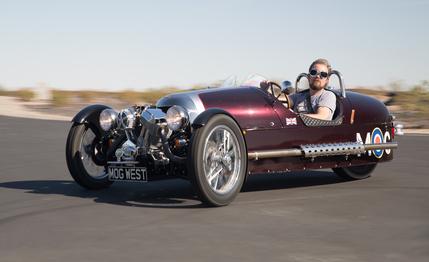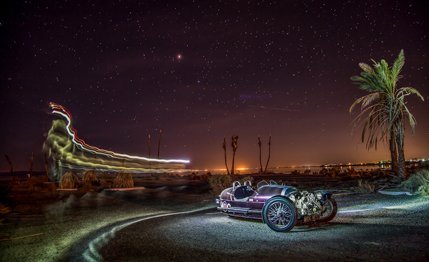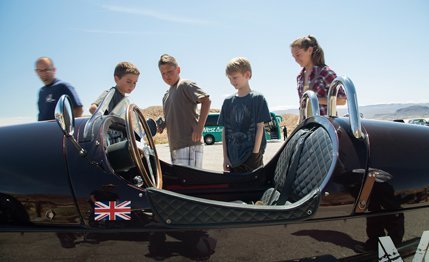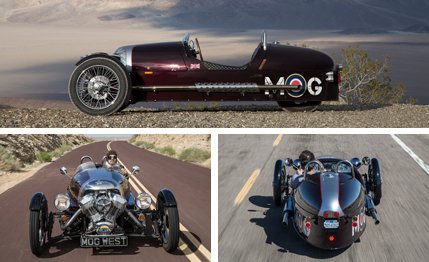
 Instrumented Test
Instrumented Test
All myths aside, the Golden State is a lonely, hard place at the edge of the continent, low on water and high on stretches of desolation. Little is preserved here; it falls into disrepair and uselessness and it’s either left behind to rot or it’s razed and replaced—sometimes with something better, sometimes not. Space isn’t what’s at a premium here; California’s got plenty of it if you prefer to live somewhere inconvenient and desperate. The high costs come because 32 million people are trying to squeeze as closely as possible to the verdant coastline, where the weather is much better.
A long-running outfit from England has produced a machine that promises to up the quality of anyone’s lifestyle. You won’t be shocked to learn that it’s also expensive. On paper its credentials are shaky: It lacks a top, a radio, and, most notably, a fourth wheel. Yet it proves a surprisingly effective vessel for surveying California’s interior, an open landscape that begs exploration. The new Morgan 3 Wheeler, an outmoded concept in which you are inches from the ground and never not outside—climate control by the sun, wind, and rain—seemed perfect for discovering démodé California.
Perhaps nothing is as quintessentially British, a finer embodiment of stiff-upper limeyness, as a Morgan trike. It looks as if it were assembled out of bombast, bicycles, and scraps of Sopwith and Handley Page aircraft. The 2013 example we picked up from Dennis Glavis’s Morgan West dealership in Santa Monica, California, looks straight out of the model’s prewar heyday. Morgan’s early Cyclecars tended to be powered by Matchless and JAP (JA Prestwich) motorcycle engines, so the bold, chrome S&S X-Wedge conker bolted to the nose of our car is its main modernistic telltale.


With a 4.25-inch bore and stroke, the 56-degree V-twin chuffs out a claimed 116 horsepower. The torque routes via a shaft to the single rear 175/65 R-15 Vredestein tire somewhat incongruously designed by the avowed modernists at Giugiaro.
Sandwiched between California’s arid Owens Valley and the even drier Death Valley lie the Searles and Panamint valleys. Scuttling over the 2600-foot pass between them and onto Panamint’s dusty flats, we passed the inaccessible remains of Panamint City, which in 1874 was a silver-mining town of 2000 so lawless that Wells Fargo refused to open an office there, calling the place “a suburb of hell.” And this was a town established by Nevada senators.
To guard against theft, the denizens of Panamint City cast their silver into 400-pound ingots, too heavy for bandit horsemen to carry off, and hauled them by mule the 150 miles to Los Angeles. Once the mines were tapped out, the road to the place washed away, and Panamint degenerated into a collection of falling-down shacks. A general store with uncertain hours in nearby Ballarat still sells a few provisions and paperback books to the legions of off-roaders who now populate the town on weekends.


Morgan, however, has often reveled in “obsolescence.” Roll up in a 1991 Plus 4, for example, and passersby could be forgiven for thinking you were driving a prewar antique. You basically are. The ash boards framing the body prove it. Yet thanks to the BBC, the Morgan brand has more vibrance than it has had in a half-century. Later, we pulled up to the only gas station in Panamint Springs (which, besides a restaurant, is more or less the only thing in Panamint Springs), and a teenager leaned out of a minivan and said, “Hey! I saw one of those on Top Gear! They were doing donuts and stuff in it!”
“This is for a Car and Driver story,” we replied.
“Car and Driver? What’s that?”
Clearly, the rotten kid hadn’t been in a dentist’s waiting room recently. Or ever. We yawped and muttered, hung a left out of the parking lot, passed a slow-moving Celica from Oregon, and blasted up State Route 190 to Father Crowley Vista. Assuming one does not get stuck behind a slow-moving tourist, that stretch of 190 is one of the most magnificent driver’s roads in California, an eight-mile uphill quickie rife with switchbacks carved into the side of the painter’s-palette Argus Range.


Face tucked down behind the vestigial windscreen to avoid a sudden shower, we decided speed was the only way to stay dry. A hailstone to the cheek only increased our resolve. The stiff pedals and Miata-sourced transmission work in concert at speed, making more sense under frenetic levering and hammering than they did while putt-putting down into the valley from Trona, a mineral-harvesting town so inhospitable to growth that its football team plays on dirt. Driving through this forlorn place, unaware of that fact, you’d assume that its football team played on dirt—right after you got over the shock that Trona has enough kids to justify having its own high school.
We pressed farther into the desert. From the tourist-trap Calico Ghost Town near Barstow, we pounded south, past the sprawling warehouse farm of the Marine Corps Logistics Base Barstow, then east to Ludlow, a town on old Route 66 that was decimated by the construction of Interstate 40 in the 1960s. Ludlow is no Radiator Springs children’s fantasy; it’s a true casualty of progress, now just a wide spot in the road that’s gradually being narrowed by the elements and desert-rat pickers.
From Ludlow, we made a straight eastward shot on a road that seems too slender to have ever linked Chicago and Los Angeles, passing the semi-preserved Googie architecture of Amboy. There was a time when Route 66’s two lanes were deemed sufficient and a vast improvement over what had come before. Tin Lizzies, Hupmobiles, and Pierce-Arrows alike trundled its rolling ribbon, and it seems cliché to note that the Morgan, after a day’s seat time, finally delivered on the promise of a special type of motoring nirvana out here.